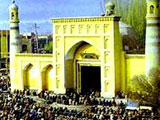 The first thing that strikes visitors in Kashgar is the city?s strong Islamic feel, which can be seen almost everywhere in the streets, from the style of architecture to the costumes of the local people. Wandering around, you may feel that you have entered an exotic Turkish city.
The first thing that strikes visitors in Kashgar is the city?s strong Islamic feel, which can be seen almost everywhere in the streets, from the style of architecture to the costumes of the local people. Wandering around, you may feel that you have entered an exotic Turkish city.
The first stop on the itineraries of most tourists is usually the majestic Id Kah Mosque, located in the center of the city. This stately landmark is the largest mosque in China and is famous in many Muslim countries. Tourists are allowed to go in when it is not prayer time or a religious holiday.
Originally built in the mid-15th century, the mosque was renovated and expanded several times in the following centuries. The building complex includes a gate tower, a courtyard, as well as many prayer halls and classrooms, all yellow and white in color and decorated with exquisite carvings and colorful paintings.
The mosque is the center of religious activities in Xinjiang, and can accommodate as many as seven thousand worshippers. In front of the mosque lies a spacious square, where people often hold grand celebrations during holy Islamic festivals such as Eid al Fitr and Eid al Adha.
About five kilometers northeast of the Id Kah Mosque lies another famous tourist site, the Abakh Hoja mausoleums. This group of Islamic-style buildings covered with glazed green tiles are the resting place for some 70 descendents of Abakh Hoja, the powerful ruler of Kashgar in the 17th century who was highly revered by the local people.
The site is best known for the tomb of Abakh Hoja's granddaughter Iparhan, who was a favorite concubine of the Qing Dynasty Emperor Qianlong of the 18th century. It?s said that the girl?s body emitted a delicate fragrance, which is why she was also known as Xiangfei, or Fragrant Concubine. After her death, over 100 people took three years to carry her coffin back to Kashgar and bury it in her family graveyard.
For many tourists, the most interesting place in Kashgar is perhaps the Sunday market, located in the northeastern outskirts of the city. Traditionally, the market was open to business only on Sunday, but now, it?s open every day, even though it?s still called the Sunday market.
In fact, the history of the market can be traced back two thousand years, when Kashgar was a flourishing trade center on the ancient Silk Road. Today, the place has become the largest free trade market in northwest China, with a customer flow of more than 100 thousand people every day. Here you can see not only local peddlers, but also many business people from central, western and southern Asian countries.
The market has thousands of stalls selling all types of goods, from handicrafts, clothes and agricultural products to daily utensils and live animals like camels, sheep, and horses. Some unique local handicrafts, such as the beautifully embroidered caps, delicate knives and high-quality tapestries are very popular as souvenirs.
If you are hungry, visit one of the many food stalls in the market and enjoy local delicacies like the shish kebab and roasted lamb shanks.
Another tourist attraction in Kashgar worth visiting is the Karakuri Lake at the foot of Mount Maztagata. The lake is 3,600 meters above sea level and is ten square kilometers in area. The snow-covered peaks reflected in the water, the luxuriant vegetation and the flocks of cattle and sheep on the pastures make for a Utopian landscape. You can enjoy the wonderful scenes on the water by taking a rubber boat. Near the banks there are yurts and log cabins where tourists can stay.
The towering Mount Maztagata beside the lake is a favorite with people who love to go mountain climbing. Its name Maztagata is a Tajik word that means ?father of glaciers?. The name is derived from a beautiful local legend that says the glaciers were created from the tears of a pretty fairy living on the mountain who was forced by the king in heaven to leave her lover. The legend has given the mountain meaning for the local people as a symbol of pure love.
As the westernmost city in China, Kashgar is a long way from just about everywhere, but the city?s convenient traffic network means getting there is not a problem. First, fly to Urumqi, capital of Xinjiang, and Kashgar is just a one and a half hour flight away. Or for the braver souls who don?t mind taking a two day trip, the train and sleeper bus offer a cheaper option.
There are many hotels in Kashgar, which are all equipped with modern facilities while at the same time retaining the strong local character.
(CRI November 6, 2002)
|

